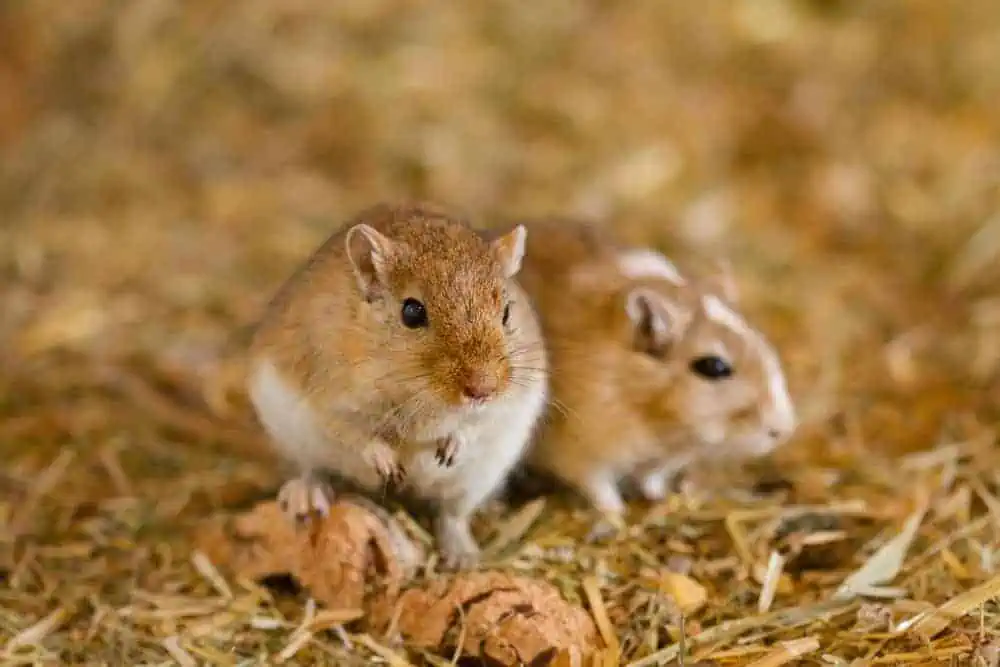Buckle up, animal lovers! We’re about to jump into the wild world of gerbils. These furry bundles of cuteness are full of surprises, and we’re here to dish them out. From their crazy jumping skills to their adorable social habits, we’ll give you the inside scoop on these fascinating creatures. So, whether you’re a gerbil pro or just want to learn more about these quirky pets, get ready for some fun-filled facts that will make you fall head over paws for these pint-sized wonders!
Fun Facts About Gerbils
Gerbils are fascinating little creatures with some pretty cool quirks. Let’s dive into the amazing world of these tiny adventurers!
They practically whisper! Okay, not really, but gerbils are known for being relatively quiet. Unlike some of their louder rodent cousins, they tend to communicate with each other through gentle chirps, squeaks, and even thumps. Some folks believe these subtle sounds are part of a complex communication system, signaling things like danger or food sources.
Master Architects: Ever seen a gerbil dig? It’s like watching a tiny construction crew! These little guys are expert burrowers, creating intricate underground tunnels and chambers. This natural talent helps them stay safe from predators and extreme temperatures in their native habitats.
They Love to Get Sand-y! Forget water, gerbils prefer to keep clean by taking luxurious sand baths. This might seem odd at first, but the sand actually helps to absorb excess oils and dirt from their fur, keeping them feeling fresh and looking their best.
Brainier than You Think: Don’t let their size fool you, gerbils are surprisingly intelligent! They can learn tricks, navigate mazes, and even recognize their human companions. Some research suggests that gerbils are capable of remembering complex routes and solving puzzles, making them far more clever than many people realize.
Family Matters: Gerbils are highly social animals who thrive in the company of their own kind. They typically live in small family groups, and experts believe they maintain strong social bonds through a combination of scent marking and physical interactions.
This is just a glimpse into the fascinating world of gerbils. As scientists continue to study these curious creatures, we are likely to uncover even more secrets about their behavior, intelligence, and social dynamics. So next time you see a gerbil, remember that there’s more to them than meets the eye!
How Intelligent are Gerbils?
We’ve talked about how cool gerbils are, but how smart are they really? You might be surprised! These little creatures are more than just cute faces; they’ve got some serious brainpower going on. They’re known for their problem-solving skills, and they can actually learn quite a bit. Ever seen a gerbil running through a maze? They can figure those out! They can also learn to recognize patterns and even tell the difference between different objects.
Their burrowing skills are next level. They’re like the architects of the rodent world, creating these amazing underground tunnel systems with different chambers for sleeping, storing food, and even hanging out. It’s pretty impressive when you think about how small they are!
Gerbils are social butterflies and love hanging out in groups. They’ve got this whole communication system going on with squeaks, chirps, and even scent signals. They form strong bonds with each other and look out for one another.
One of the coolest things about gerbils is their adaptability. They can thrive in all sorts of environments, from dry deserts to grassy plains. Plus, they aren’t picky eaters. Seeds, grains, insects – you name it, they’ll probably munch on it!
Scientists are still learning a lot about how gerbils think and learn. Some experts believe their intelligence might even be underestimated. It’s fascinating to think about what else we might discover about these clever little creatures in the future!
How High Can Gerbils Jump?
Okay, so you’ve heard that gerbils are surprisingly good jumpers, right? It’s not just a rumor; these little guys have serious hops! We’re talking up to 12 inches (30 cm) straight up! That’s like a tiny, furry rocket taking off. To put it in perspective, that’s about the height of a soda can – pretty impressive for a creature that’s only about the size of your hand!
Why all the jumping, you ask? Well, it’s in their DNA. Wild gerbils use their leaping skills to escape predators, navigate their desert homes, and snag tasty treats. It’s a key part of how they survive.
And it’s not just about height. Gerbils are known for their agility in the air, often twisting and turning mid-jump. This acrobatics come in handy when they need to make a quick getaway or show off their moves to their gerbil buddies.
Of course, not all gerbils are Olympic-level jumpers. Just like humans, some are more athletic than others. Age, health, and even just a gerbil’s personality can play a role in how high they like to leap.
Researchers are still unraveling all the mysteries of gerbil jumping. There’s a lot we don’t know about the biomechanics of their leaps, how their environment influences their jumping style, and even the role jumping plays in their social interactions. It’s a fascinating field of study!
So, the next time you see a gerbil seemingly defy gravity, remember that it’s not just playful fun (though it certainly is that too!). It’s a testament to their amazing adaptations and a window into the fascinating world of these tiny but mighty creatures.
What Do Gerbils Do for Fun?
Just like us, gerbils need their entertainment! They’re not just about burrowing and snacking, though those are definitely high on their list. Let’s dive into the fun stuff gerbils are all about.
One thing you might not expect? Gerbils love a little action! We’re talking playful boxing and wrestling matches with their buddies. It’s all in good fun, of course, and it helps them get their energy out. Think of it like their version of a friendly game of tag!
Gerbils are incredible burrowers. In the wild, their tunnels are super complex, like underground mazes with different rooms for sleeping, storing food, and making quick escapes. It’s pretty amazing to see how they use their digging skills to create their own little worlds.
Gerbils are also surprisingly good jumpers. We’re talking up to a foot high in a single bound! This helps them get around quickly, whether they’re escaping danger or just exploring their surroundings.
Now, gerbils might not be chatting up a storm like us, but they’ve got their own ways of communicating. They use a mix of sounds, body language, and even scents to get their message across. It’s like their own secret language, and it’s fascinating to watch them interact with each other.
Gerbils love to burrow and hoard food, and sometimes they take that playful energy to their food, too! They’ll engage in something called “play hunting,” where they chase after their food as if they’re catching it in the wild. It’s like they’re reminding themselves of their natural instincts, but in a fun, safe way.
Sometimes, they even extend this “play hunting” to other objects in their environment. You might see them playfully tossing or pushing around small toys or even just random things they find in their cage. It’s like they’re trying to herd them, which is another behavior they might exhibit in the wild.
Learning about the fun things gerbils do gives us a whole new appreciation for these amazing creatures. They’re not just cute and cuddly; they’re smart, playful, and full of surprises. So next time you see a gerbil, remember that there’s a whole lot more going on beneath the surface than meets the eye!
Will a Gerbil Cuddle?
So, you’re curious about whether those adorable, whiskered little creatures called gerbils are into cuddling? You’re not alone! It’s a question that pops up a lot, and the answer, like many things in the animal kingdom, isn’t a simple yes or no.
Think of it this way: gerbils are social butterflies of the rodent world. They really thrive in pairs or small groups, and just like us, they show affection to their buddies. But instead of grand gestures, their love language is all about the little things.
Picture this: a pile of fluffy gerbils snuggled up together, fast asleep. That’s their version of a group hug! It’s not just about being warm and cozy (although that’s definitely a bonus!). Cuddling up provides a sense of security and strengthens their bonds.
And speaking of bonding, have you ever seen gerbils grooming each other? It’s like a mini spa day, with one meticulously cleaning the other’s fur. This isn’t just about hygiene; it’s a sign of deep trust and affection.
Now, cuddling with their human friends is a bit of a different story. Some gerbils might be open to a little head scratch or even a quick snuggle. Others are more comfortable socializing with their gerbil pals. Just like people, each gerbil has its own personality, and respecting their boundaries is key to a happy relationship.
So, while a gerbil might not be a cuddle-monster in the traditional sense, they definitely show affection in their own special ways. Observing their social interactions and learning their unique personalities is part of the joy of having these playful and fascinating creatures in your life!
What is the Lifespan of a Gerbil?
Gerbils are actually some of the longer-living rodents out there. You can generally expect them to be part of your life for a good two to three years. Now, that’s just an average, like saying most humans live to be around 70 – some folks make it way past that! And the same goes for gerbils. With a bit of luck, great genes, and the right care, your little buddy could be bouncing around for five years or even more.
Think of it like this: a healthy diet is like giving your gerbil a magical potion for a long life, and a stress-free, enriching environment is like removing any sneaky aging curses. It all adds up! There’s still a lot we’re learning about what makes some gerbils live longer than others, but those are some key ingredients.
Are Gerbils Faster Than Hamsters?
So, we’ve talked about how surprisingly speedy these little guys can be, but what about comparing them to their hamster cousins? Who would win in a tiny rodent race?
Well, it’s tricky to say for sure! While hamsters are no slouches when it comes to scurrying, gerbils are generally thought to be the quicker of the two. This might be because their bodies are a bit more built for speed – think longer legs and a sleeker shape. They’ve got those marathon runner legs, while hamsters are built a bit more for power.
Now, some folks will tell you a gerbil can hit a top speed of 6 miles per hour! That’s pretty darn fast when you consider their size. Imagine a tiny, furry bullet zipping around! Of course, this doesn’t mean every gerbil is out there breaking land speed records. Just like with people, some are naturally faster than others.
It’s important to remember that a lot of what we know about gerbil speed comes from observing them in captivity. Out in the wild, things might be a bit different. They’d be dodging predators and navigating all sorts of terrain, so their speed could be even more impressive!
To sum it up, while we can’t say for certain who would win a gerbil vs. hamster sprint, the evidence seems to point to gerbils having the edge. But hey, maybe one day someone will organize a proper scientific study to settle the debate once and for all! Until then, we can keep enjoying the zippy antics of these fascinating little creatures.
How Fast Can a Gerbil Run?
So, we’ve established that gerbils are pretty zippy creatures. But just how fast can these little guys go? Well, studies suggest they can hit some pretty impressive speeds for their size, clocking in at up to 10.8 kilometers per hour (or 6.7 miles per hour for those of us who think in miles). To put that in perspective, that’s like a tiny, furry rocket darting across your living room!
Now, it’s important to remember that not all gerbils are created equal in the speed department. Just like us humans, their age, how healthy they are, and even their weight can play a big role in how quickly they can move. A young and fit gerbil is going to be much faster than an older, maybe slightly plumper one. And speaking of staying in shape, a good diet is key! Feeding your gerbil a balanced and nutritious diet isn’t just about keeping them healthy overall, it also gives them the energy they need to reach those top speeds.
But sprinting isn’t their only talent. These little guys are also incredible diggers—we’re talking lightning-fast tunnel construction here! It’s pretty clear that gerbils are built for speed, both above and below ground. Their speed helps them avoid danger in the wild and, let’s be honest, provides endless entertainment for us as we watch them zoom around their enclosures.
How Long Can Gerbils Go Without Food?
Okay, so you’re probably wondering how long your little gerbil buddy can handle it if their food bowl runs dry. Well, the good news is, these critters are surprisingly tough! Gerbils are adapted to sometimes scarce desert environments, so they’ve evolved to deal with a little hunger now and then.
Think of it like this: they’re like the camels of the rodent world! They can actually survive for a good 3 to 4 days without a single nibble, as long as they have water. Water is super important, though. Without it, things get risky much faster.
Now, just because they can go that long doesn’t mean they’re exactly happy campers. Imagine if you skipped a few meals – you’d probably feel a bit grumpy and low on energy, right? Same goes for gerbils. They can usually make it about 24 hours without showing too much distress, but after that, you might notice them getting a bit sluggish.
Why are they so good at handling hunger pangs? Well, gerbils have these neat little metabolisms that are super efficient. They’re like the ultimate energy savers. Plus, they’re natural hoarders (relatable, right?). They love to stash away food, which comes in handy when times get tough.
Remember, while it’s good to know they can handle a missed meal or two, it’s always best to keep that food bowl stocked. A happy gerbil is a well-fed gerbil!
Do Gerbils Have Long Tails?
So, we’ve been talking about gerbils, and you might be wondering about their tails. It’s a good question! Generally speaking, a gerbil’s tail length is often proportionate to its body size. This means that if you have a gerbil with a longer body, it’s likely to have a longer tail too.
Think of it like this: imagine a tiny, delicate pygmy gerbil next to a larger, sturdier Mongolian gerbil. The pygmy gerbil will probably sport a shorter, more delicate tail, while the Mongolian gerbil’s tail will be a bit more prominent.
Now, there are always exceptions to the rule, right? The North African gerbil is a prime example. These guys are on the larger side, and their tails tend to be remarkably long, often matching the length of their bodies. It’s pretty impressive!
You might be wondering why gerbil tails are so noteworthy. Well, those tails aren’t just for show! They play a vital role in helping gerbils keep their balance, especially when they’re scampering around or navigating tricky terrain. Not only that, but their tails also help them communicate with each other through subtle movements and signals. Fascinating, right?
Did you know that La Tomatina, the world’s largest tomato fight, uses more than 120,000 pounds of tomatoes? fun facts about la tomatina Did you also know that left-handed people are more likely to be creative and artistic? fun facts about lefties

















2 thoughts on “Delightful Discoveries: Fun Facts About Gerbils”
Comments are closed.